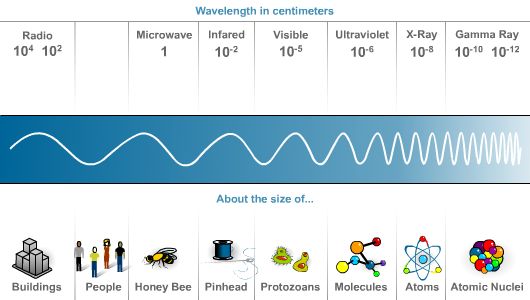|
Teacher Lesson Pages
Whenever we turn on a computer, stove, or radio, get an x-ray for a broken leg, focus a laser beam, or put on
sunscreen, we are trying to use and manage some form of electromagnetic radiation.
 When it is your friend, it is being used by your TV to present glowing images on a screen or being used to pop
popcorn in that bag in the microwave. Right now, friendly electromagnetic radiation is in the light bulb above you.
When it is your foe, it is in the form of x-rays, gamma rays, or ultraviolet rays that can penetrate the cells of
your body and cause cancers.
When it is your friend, it is being used by your TV to present glowing images on a screen or being used to pop
popcorn in that bag in the microwave. Right now, friendly electromagnetic radiation is in the light bulb above you.
When it is your foe, it is in the form of x-rays, gamma rays, or ultraviolet rays that can penetrate the cells of
your body and cause cancers.
Electromagnetic energy is all around us. It cooks our food (microwaves), enters our eyes (visible light), touches
our skin and warms us (infrared), penetrates our bodies (X-rays), threatens our cells (ultraviolet rays), and
provides plants with the energy to conduct photosynthesis (visible light). Some forms of it are relatively easy
to control. Some forms are hard to control and can be very dangerous to humans.
The Make-up of Radiation
Electromagnetic radiation has a number of names: electromagnetic energy, electromagnetic waves, or radiation. These names might
confuse you, but they mean the same thing! You might be confused even more when scientists call electromagnetic energy both friend
and foe! There are seven different kinds of electromagnetic energy—some are helpful and some are harmful.
Electromagnetic waves are given off from any source of energy. This includes such common energy sources as a heated metal pan, an
electric wire, or a flashlight. Making up the radiation are particles called photons. Each photon is an extremely small grain of
energy—an energy packet.
The seven types of electromagnetic radiation have two things in common:
- They all travel in waves—think waves in an ocean.
- They all travel at the speed of light—300,000 km/sec (186,000 miles/sec)!
Looking for Electromagnetic Radiation
Radiation is everywhere! Look closely at the following diagram. Electromagnetic energy moves in waves and occurs in a range of
wavelengths.

Here are the different waves making up the electromagnetic spectrum and how scientists (and all of us) put them to work:
- Radio waves. The longest waves, which are relatively low in energy, are used to
produce radio and TV signals.
- Microwaves. Slightly higher in energy, microwaves are used in a microwave oven
to prepare food.
- Infrared. These waves are used in short distance wireless communication devices,
such as pagers, cell phones, and laptops.
- Visible light. These waves, coming from such sources as the sun or a light bulb,
enter our eyes at the speed of light and stimulate our eyes' nerve endings to send the "idea" of the image to our brains.
- Ultraviolet rays. Coming from the sun, these rays can produce a suntan, a sunburn,
aging effects, and skin cancer. To protect our skin from ultraviolet rays, we apply sunscreen.
- X-rays. These rays penetrate the skin and help doctors to look at our skeleton and
find and fix broken bones.
- Gamma rays. Produced in the center of the sun, in nuclear power plants, and in
atomic bombs, gamma rays have the shortest wavelengths and are most dangerous to humans.
Electromagnetic waves with more energy than visible light can be dangerous. These forms of energy can change the atomic structure
of molecules in our skin and potentially cause skin cancer. X-rays and gamma rays can penetrate our bodies and alter the structure
of DNA molecules. Some organs in our bodies, especially those that we depend upon to produce lots of new cells, such as the liver,
blood cells, and the brain, are particularly susceptible to change by high-energy radiation.
Electromagnetism and Astronauts
The space station orbits above the protective layers of our atmosphere. Scientists have discovered that the sun creates every form of
radiation. During intense periods of solar events, harmful X-rays, gamma rays, and electrically charged atomic particles are being
constantly monitored by highly sensitive technology on board the space station and by satellites. This radiation can penetrate the
space station’s outer hull and put the astronauts in danger.
Check for Understanding
Answer the following questions to see how much you know about electromagnetic radiation.
- What is electromagnetic radiation?
- Where would I find electromagnetic radiation?
- Is radiation all the same?
- List some types of electromagnetic energies and give an example of how you have experienced them.
- Why is it important to monitor the radiation levels on board the space station?
|


